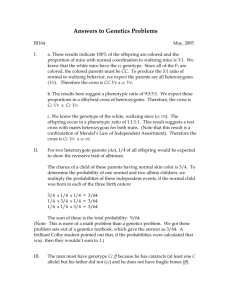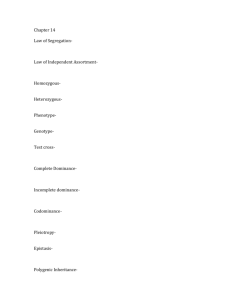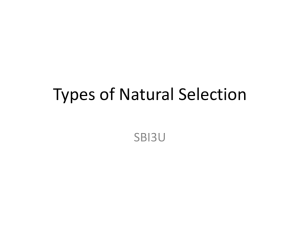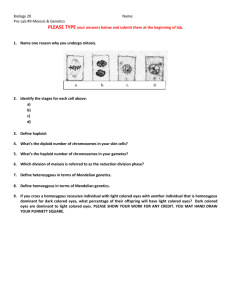Genetics Problem Set
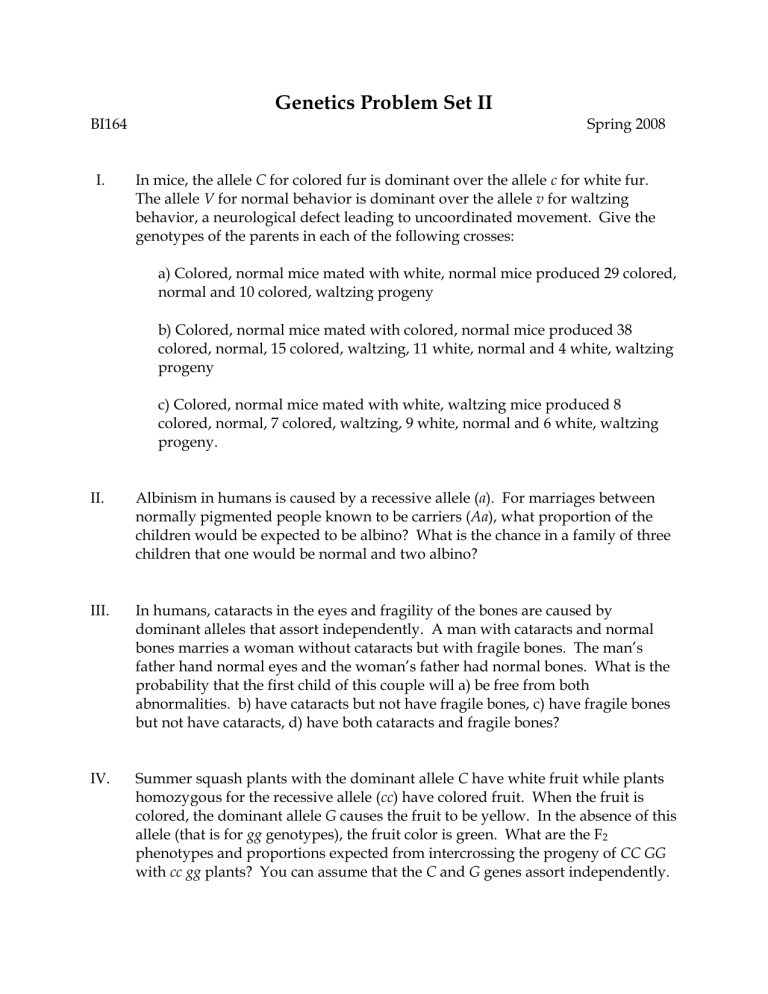
Genetics Problem Set II
BI164 Spring 2008
I. In mice, the allele C for colored fur is dominant over the allele c for white fur.
The allele V for normal behavior is dominant over the allele v for waltzing behavior, a neurological defect leading to uncoordinated movement. Give the genotypes of the parents in each of the following crosses: a) Colored, normal mice mated with white, normal mice produced 29 colored, normal and 10 colored, waltzing progeny b) Colored, normal mice mated with colored, normal mice produced 38 colored, normal, 15 colored, waltzing, 11 white, normal and 4 white, waltzing progeny c) Colored, normal mice mated with white, waltzing mice produced 8 colored, normal, 7 colored, waltzing, 9 white, normal and 6 white, waltzing progeny.
II. Albinism in humans is caused by a recessive allele (a). For marriages between normally pigmented people known to be carriers (Aa), what proportion of the children would be expected to be albino? What is the chance in a family of three children that one would be normal and two albino?
III. In humans, cataracts in the eyes and fragility of the bones are caused by dominant alleles that assort independently. A man with cataracts and normal bones marries a woman without cataracts but with fragile bones. The man’s father hand normal eyes and the woman’s father had normal bones. What is the probability that the first child of this couple will a) be free from both abnormalities. b) have cataracts but not have fragile bones, c) have fragile bones but not have cataracts, d) have both cataracts and fragile bones?
IV. Summer squash plants with the dominant allele C have white fruit while plants homozygous for the recessive allele (cc) have colored fruit. When the fruit is colored, the dominant allele G causes the fruit to be yellow. In the absence of this allele (that is for gg genotypes), the fruit color is green. What are the F
2 phenotypes and proportions expected from intercrossing the progeny of CC GG with cc gg plants? You can assume that the C and G genes assort independently.
V. The pedigree below shows the inheritance of a recessive trait. The individuals whose symbols are gray are affected. Unless there is evidence to the contrary, assume that the individuals who have married into the family do not carry the recessive allele. Determine the chance that the offspring of the following matings will show the trait:
III-1 x III-12
III-4 x III-14
III-6 x III-13
IV-1 x IV-2
VI. A locus has three alleles, A
1
, A
2
and A
3
with frequencies of 0.6, 0.3 and 0.1, respectively. Assuming random mating, what are the expected frequencies of all the heterozygotes in the population?
VII. Humans carrying the dominant allele T can taste the substance phenylthiocarbamide (PTC). (Tasters find PTC extremely bitter.) In a class of 25 students, 14 students were found to be PTC non-tasters (tt). The other 11 were tasters (either Tt or TT). How many tasters were heterozygous?

